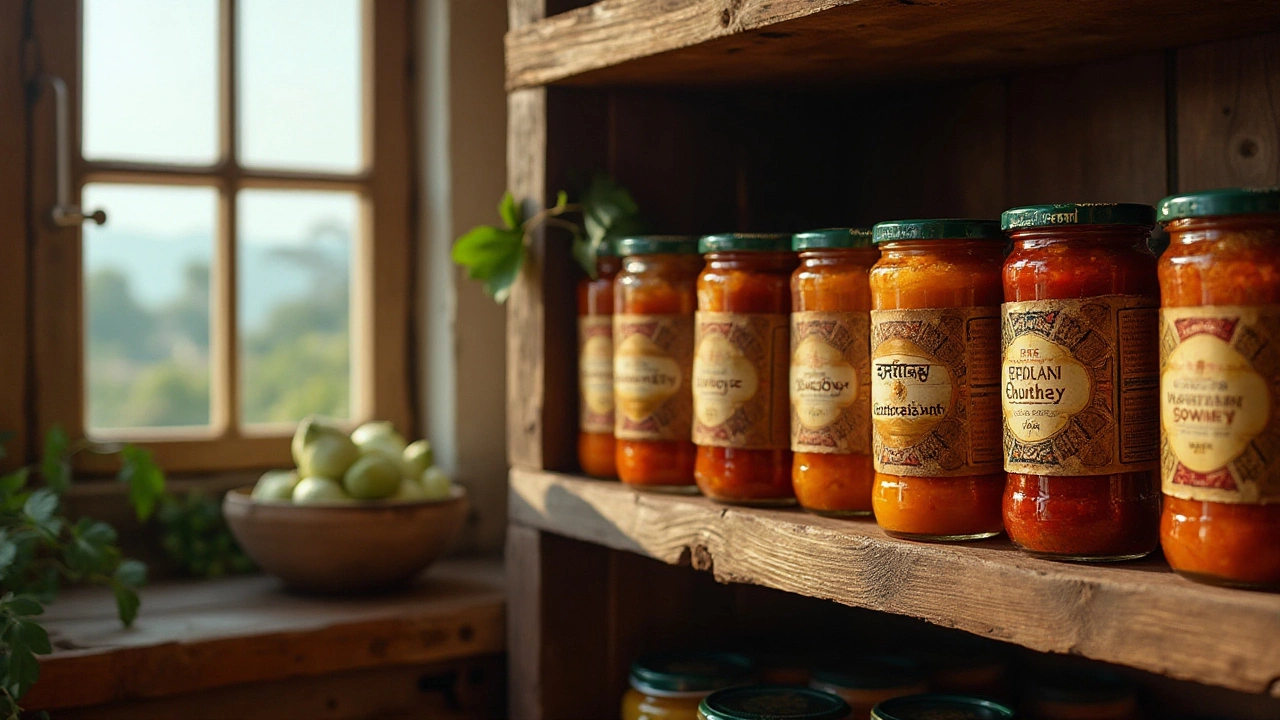Chutney, with its vibrant flavors and versatile uses, is a beloved staple in many kitchens. Whether sweet, spicy, or tangy, it brings a distinct charm to the table. Crafting your own chutneys at home has the added advantage of customizing flavors to suit your preferences.
But how long can you keep your homemade chutney in a jar before it loses its zest? Understanding the storage life of chutney is crucial not just for enjoying its flavor, but also for ensuring safety and preserving its quality. Let's delve into useful tips and insights that help maintain the delightful essence of your homemade creation for as long as possible.
- Understanding the Basics of Chutney Preservation
- Factors That Affect the Shelf Life of Homemade Chutney
- Best Practices for Storing Chutney in Jars
- Signs That Your Chutney Has Gone Bad
- Tips for Extending Chutney Shelf Life
Understanding the Basics of Chutney Preservation
Nurturing a jar of homemade chutney is both a culinary pleasure and a delicate science. The art of preserving chutney involves maintaining its vibrant flavors while ensuring it remains safe for consumption over time. A well-preserved chutney doesn't just tantalize taste buds; it also offers a glimpse into the rich history of preservation techniques passed down through generations. From the traditional Indian kitchens where chutney originated to the modern Western pantry, the preservation methods used today are both diverse and effective, largely relying on sugar and vinegar as natural preservatives.
Vinegar, with its acidic nature, plays a crucial role in the preservation of chutney by lowering the pH level, which inhibits the growth of harmful microorganisms. This means that homemade chutney, when prepared correctly, can often be stored at room temperature if sealed properly, making it both convenient and delicious for months. On the other hand, sugar serves not only as a sweetener but also as a preservative by drawing water out of microbial cells, thereby preventing spoilage. Alongside vinegar and sugar, the sterility of the jars and careful sealing techniques are key components in maximizing the preservation potential of chutney. Ensuring that jars are properly sterilized before use is essential in extending the shelf life of chutney, preventing the entry of unwanted bacteria or mold.
In some cases, salt is added to the recipe for preservation. Salt, much like sugar, helps inhibit microbial growth through dehydration. This synergistic relationship between vinegar, sugar, and often salt creates an environment where chutney can thrive in its preserved state without the need for artificial additives. However, it is crucial to follow recipes closely and ensure that enough acidity and sugar content are present to keep the chutney preserved effectively. On a warm afternoon, a well-preserved chutney can turn a simple dish into a refreshing feast. A successful preservation process ensures that every bite retains its essence, layering a dish with sensory depth.
According to a food preservation expert, "The careful balance of acid and sugar in chutneys allows them to last without refrigeration, but meticulous sealing is what truly defends against spoilage."
– Francesca Lamping, Preserving Heritage ExpertSuch expertise highlights the harmonious blend of science and tradition at play. While modern conveniences offer options such as refrigeration or dye packets to enhance color, sticking to straightforward, natural preservative methods is often preferred, lending authenticity and purity to your creation. By mastering these basics, you'll savor the sight of a graceful ladle of homemade chutney softening buttered bread or swirling through warm grains, each scoop embodying a timeless balance of sweet, tangy, and savory.
Factors That Affect the Shelf Life of Homemade Chutney
Understanding the intricacies of how various elements influence the longevity of your homemade chutney is essential for maintaining its deliciousness and quality over time. One of the primary factors is the acidity level of the chutney. Chutneys that are higher in acidity tend to last longer as the acidic environment inhibits the growth of bacteria and molds. This is why vinegar, lemon juice, or lime juice is often added in recipes, not just to enhance flavor, but also as a preservation technique.
Another crucial element is sugar content. Sugar acts as a natural preservative, helping to prolong the shelf life of your chutney. Many traditional recipes call for a generous amount of sugar, which helps preserve color and texture, in addition to flavor. Similarly, the type of container you use plays a role. Airtight glass jars are ideal because they prevent contamination from external elements. Plastic containers are not as effective due to possible chemical leaching and permeability that could affect the chutney's taste and lifespan.
It's also worth mentioning the importance of cooking and sealing processes. Properly cooking chutney ensures that all ingredients are infused while also breaking down elements that could spoil the freshness. The sealing process is vital; jars need to be sterilized and sealed tight while the chutney is hot to create a vacuum that bars entry to bacteria. According to culinary expert Jane Grigson, "The art of preserving lies in minute attention to detail; it's the small things that make a big difference."
Temperature and storage conditions cannot be ignored. A cool, dark place like a pantry or cupboard, away from direct sunlight, offers the best environment for chutney storage. Extreme temperature fluctuations can affect the texture and can spur the growth of unwanted bacteria. It's interesting to note that new trends are emerging where some people opt to store chutneys in refrigerators to further extend their shelf-life. However, this might not be feasible if storage space is limited.
Finally, one must also consider the impact of ingredients beyond just sugar and vinegar. Spices and fruits themselves can affect how long chutney lasts. For example, mango chutneys may have a different shelf life than those made with green tomatoes due to their fruit compositions. Making a note of these elements helps you adjust recipes to tailor preservation with taste.

Best Practices for Storing Chutney in Jars
Embracing the art of preserving must be paired with the wisdom of storage when it comes to homemade chutney. Getting this just right ensures your delicious creation remains as fresh and tantalizing as the day you jarred it. Preserving chutney effectively involves several techniques, each tailored to protect the delicate balance of flavors in your condiment. The basis of successful storage starts with understanding the impact of temperature, light, and even the jar's integrity on the chutney's *shelf life*. Properly sterilizing jars before filling them is a non-negotiable step. This simple act can prevent bacterial growth, preserving your chutney for an extended period.
Once filled, sealing the jar correctly is vital. A vacuum-sealed jar, achieved through water bath canning, ensures that no air enters and spoils the chutney. Placing the jars in a boiling water bath not only tightens the lid seal but also adds an extra layer of safeguarding through heat, which wards off bacteria. Store your homemade chutney in a cool, dry place. This environment slows down the degradation of flavors and preserves the texture. Many enthusiasts advocate for dark pantry shelves as the ideal resting place to shield them from sunlight's detrimental effects.
"A jar of chutney is like a small, flavorful diary of fruits and spices, and should be as carefully stored as a good story," explains culinary expert Jamie Purviance.
The choice of jar matters more than one might assume. Always opt for glass jars with airtight lids; they don't react with acidic chutneys and keep them pristine. After opening, refrigeration becomes mandatory to ensure the chutney retains its quality without compromise. A trick to extend the life of opened chutneys is to always use a clean spoon when serving. This prevents contamination and keeps every spoonful fresh.
For those who enjoy making chutney in larger quantities, small jars might be more suitable than filling a few large ones. This not only provides convenience but also reduces exposure to air whenever you use a portion. These tiny jars make sharing your chutney a heartfelt gift – spreading the joy of homemade goodness. If you maintain these best practices for storing chutney, your jars can accompany many meals to come, bringing joy long after they have been preserved.
Signs That Your Chutney Has Gone Bad
Your homemade chutney, made with love and a medley of flavors, surely holds a special place in your culinary adventures. However, like any other food product, chutney too has a shelf life. It's not always easy to determine just by looking at it whether it has gone past its prime. When storing up those beautiful jars of preserved goodness, it's imperative to keep a keen eye out for changes that can signal spoilage. Understanding these signs can ensure that you're savoring a safe and flavorful condiment every time.
First and foremost, inspect the chutney storage jar for any bulging or swelling of the lid. This can indicate fermentation or the production of gases by unwanted bacteria. When you open the jar, hear the sound carefully; a conspicuous pop might suggest a compromised seal. Once opened, examine the surface of the chutney. Mold is an absolute giveaway that your chutney has gone bad. Even a small speck can rapidly affect the entire jar, making it unsafe to consume. Remember, scraping off the mold from the top is not an adequate solution, as the toxins may have already spread below the visible surface.
Smell is another crucial sense when assessing your preserving chutney. A pungent, off-putting, or sour smell distinct from its original aroma points towards spoilage. Chutneys are known for their vibrant and often sweet and spicy scents, so anything that deviates significantly from this should be treated with suspicion. Taste, on the other hand, should only be used as a last resort for testing. If anything seems off before this point, it's safer to discard the chutney than risk an unpleasant—and potentially unsafe—tasting experience.
Texture changes, though subtle, can also provide hints. Typically, chutney has a consistent texture depending on its ingredients: some might be chunky, while others might have a saucier composition. If you notice any inclination towards sliminess or any layer of liquid separate from the main blend, it could mean the ingredients are breaking down. To avoid spoilage, it's crucial to adhere to proper chutney recipes which guide storage practices from the outset.
“Paying attention to the smallest signs of spoilage is key to ensuring food safety and enjoyment,” notes renowned chef and preservation expert, Alice Waters.
Finally, it's worthwhile to periodically check your chutney jars even before opening. Monitoring their integrity is not limited to the contents inside but also to the state of the jar itself—a crack or chip unnoticed can lead to contamination. As a helpful tip, label your jars with the date they were made, which helps you quickly assess their age at any given point. Keeping these signs in mind ensures that your chutney remains a delicious and safe addition to your meals for as long as it lasts.

Tips for Extending Chutney Shelf Life
Preserving the vibrant flavors of your homemade chutney and ensuring it lasts in your pantry requires a little bit of know-how and technique. While chutney storage might seem as simple as placing a jar in your cupboard, there are several nuanced steps that can make all the difference. First and foremost, the sterilization of your jars is crucial. Before filling them with your delicious concoction, ensure that the jars and their lids are thoroughly cleaned and sterilized. This can typically be achieved by boiling them in water or placing them in a hot oven, which helps eliminate any bacteria that could taint the chutney.
Once sterilization has been achieved, carefully fill each jar with the chutney, leaving just a small space at the top to allow for any expansion during storage. As you fill, it’s helpful to tap the jars gently to remove air bubbles, which can promote spoilage if trapped inside. After sealing the jars tightly, consider employing the water bath canning method. This traditional preservation technique involves placing the sealed jars in a pot of boiling water for a specified time, creating a vacuum seal that locks in freshness and keeps any harmful bacteria out.
Storage conditions play a pivotal role in preserving chutney as well. Store your jars in a cool, dark place. Exposure to light and heat can diminish the chutney’s quality over time. For longer preservation, refrigeration can be beneficial, even if the chutney doesn't require it initially. Some seasoned chutney makers believe in creating a spice-infused oil layer on top of the chutney as an additional barrier against air and contaminants.
Labeling is another important, yet often overlooked, aspect of chutney storage. Clearly marked labels with the date of preparation are crucial for keeping track of the chutney's age. While chutney can last up to a year in a properly sealed jar, regular checks on the condition of your preserved goods are wise. Remember, even the best-kept chutney might need a checkup after some months. An admirably thoughtful tip comes from the culinary queen, Nigella Lawson who stated, "Preserving food is more than just about taste; it's about preserving memories and moments we live for."
If you are a chutney enthusiast aiming to keep the burst of your condiments alive, consider experimenting with varied ingredients and acid levels. Some fruits and vegetables naturally have preserving qualities, such as apples and tomatoes, which can enhance chutney lifespan while adding unique layers of flavor. Additionally, let's not forget that vinegar and lemon juice aren't just for taste; their acidity keeps harmful bacteria away, thus enhancing the chutney's shelf life.
